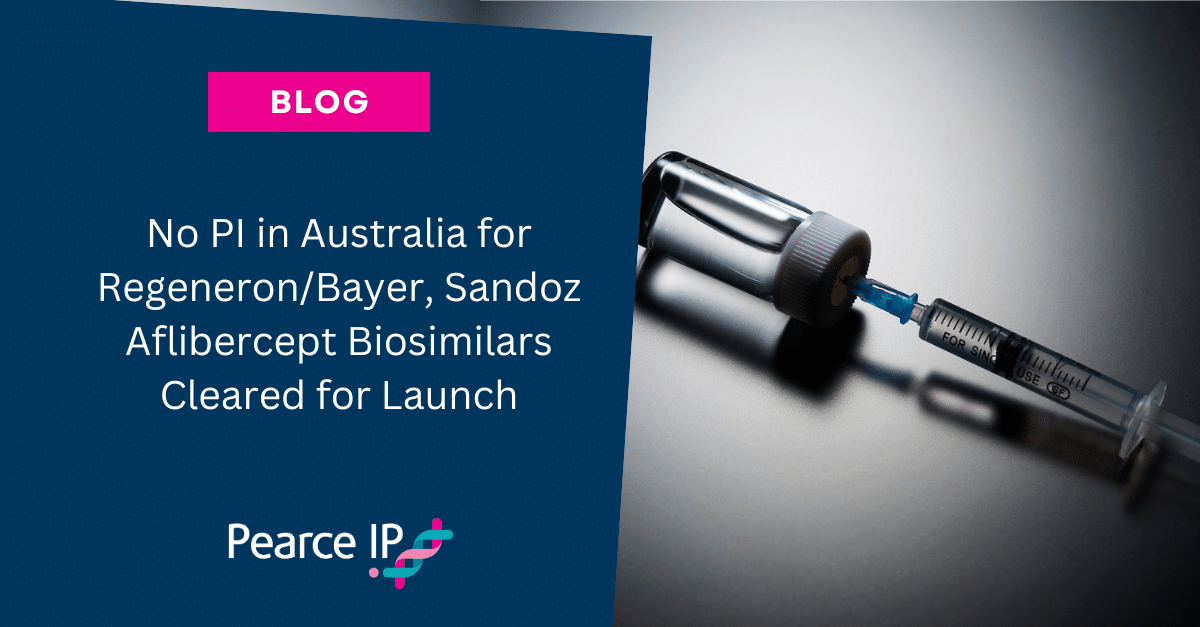| Date of decision: | 3 September 2025 (reasons published 8 September 2025) |
| Body: | Federal Court |
| Adjudicator: | Justice Rofe |
Introduction
No interlocutory injunction (‘preliminary injunction’ or ‘PI’) has been granted in any pharmaceutical patent dispute since 2018. The Federal Court’s refusal last week of Regeneron and Bayer’s PI application against Sandoz relating to their AUD$500M/year blockbuster aflibercept (Eylea®) fortifies this trend.
Justice Rofe denied Regeneron and Bayer’s application for PI on MOT patent AU2012205599 restraining Sandoz from launching its biosimilar aflibercept (Afqlir® and Enzeevu®) in Australia.
Her Honour dismissed the PI application finding “insufficient likelihood of success in all the circumstances” and that the balance of convenience did not favour the grant of the broad injunction sought. Key considerations were: non-infringement based on claim construction, and Regeneron’s own market cannibalisation through the transition of patients to Eylea® 8mg. Notably, in refusing to grant a PI, Justice Rofe rejected arguments about international price referencing effects from President Trump’s ‘Most Favored Nation’ [sic] executive order as “speculative” due to uncertain policy implementation and the possibility that other reference countries might have the lowest price (or second lowest to Australia by a small margin).
Sandoz has provided undertakings for its parent company to submit to Australian jurisdiction with joint liability up to $100 million (to the extent that Sandoz Ltd is unable to meet its obligations for any award of pecuniary relief in the proceeding), and to maintain detailed sales records.
Background
The dispute concerns Regeneron’s patent AU2012205599 (the Patent) claiming methods for treating angiogenic eye disorders using aflibercept via specific dosing regimens. Aflibercept is marketed as Eylea® by Bayer.
Sandoz obtained ARTG listings for its 2mg aflibercept biosimilars, Afqlir® and Enzeevu®, in May 2025, with PBS-listing to take effect from 1 December 2025 and launch of Afqlir® intended immediately thereafter. Regeneron and Bayer (hereafter Regeneron) sought PI in July 2025 to prevent Sandoz’s Australian Afqlir® launch (noting that Sandoz did not intend to launch Enzeevu® in the immediate future) and to force withdrawal of Sandoz’s PBS application. The PI application was heard by Justice Rofe on 14 August 2025 and the decision was delivered 3 weeks later denying PI.
Consideration
The application for PI turned on two questions: whether the Regeneron had established a prima facie case of infringement (including consideration of Sandoz’s invalidity cross-claim); and where the balance of convenience lay.
Prima Facie Case of Infringement Failed – Patent Likely Not Infringed
Regeneron alleged that Sandoz infringed the MOT Patent pursuant to:
- sections 117(2)(b)-(c) of the Patents Act 1990 (the Act) (infringement by supply), on the basis that Sandoz has reason to believe that doctors would use the products in the manner claimed by the Patent (section 117(2)(b)) and that the Sandoz product information contains instructions or inducements to use Sandoz’s aflibercept products in the manner claimed by the Patent; and
- section 13 of the Act, on the basis that Sandoz has authorised the infringing use by doctors.
Critically, Justice Rofe found that there is a real prospect that the use of Sandoz’s aflibercept products in accordance with the product information will not infringe the Patent and so did not consider that Regeneron has a strong prima facie case of infringement. Her Honour reached this view for the following two key reasons:
1) The Patent claims were to a dosing regimen measured in weeks, specifically:
(i) sequential administration of initial, secondary and tertiary doses;
(ii) secondary doses administered 2 to 4 weeks after the immediately preceding dose; and
(iii) tertiary doses administered 8 weeks after the immediately preceding dose.
In contrast, Sandoz’s product information instructed dosing “per month” for secondary doses and “every two months” for tertiary doses.
Justice Rofe considered that four weeks is not equivalent to a month, and that eight weeks is not equivalent to two months, regardless of whether prescribing practice treated them as equivalent. Her Honour noted that the Patent consistently used “weeks” throughout the specification, and “the patentee deliberately chose to use weeks rather than months in the claims, and not to adopt qualifiers such as ‘at least’ or ‘from’ or ‘around’”.
Applying Glass Hardware v TCT Group Pty Ltd (2024) 182 IPR 1, Justice Rofe rejected Regeneron’s construction arguments seeking to broaden the words of the claims beyond their ordinary English meaning, noting, for example, that although 4 weeks may be equivalent to a month in February, this is not the case for the remaining 11 months of the year.
2) Many ophthalmologists follow their own ‘treat-and-extend’ regimen in lieu of the regimen described in the product information.
Her Honour rejected Sandoz’s arguments that the product information did not constitute:
- an instruction because of the permissive language used in the product information; and
- “instructions” that were “given” to ophthalmologists in accordance with section 117(2)(c) because “given” required direct physical transfer from Sandoz to the clinician.
In relation to the latter argument, her Honour found that such a construction:
- is inconsistent with the practical realities of modern medicine, where pharmaceutical product information is easily accessible via the internet;
- excludes forms of provision previously held to be within the meaning of “given”; and
- is inconsistent with the regulatory requirements of the Department of Health and Aged Care.
Further, the TGA’s Guidelines for Prescription Medicines expressly contemplates that product information is “supplied to” or “given to” consumers upon its upload to the TGA website.
Her Honour noted that unlike cases relating to products which included “emphatic instructions” against infringing use, the product information’s therapeutic indications overlapped with the Patent claims.
Invalidity Position Did Not Shift ‘Serious Issue to be Tried’
Sandoz challenged the Patent on three grounds: lack of novelty, inventive step, and support. None of these were determinative of the application.
Novelty: Sandoz’s novelty challenge was not determinative in avoiding PI. Justice Rofe found a “information deficiency” in the prior art. While the prior art documents disclosed the use of ‘aflibercept’ and described dosing regimens, as well as ‘VEGF-Trap-Eye’ having the same molecular structure as aflibercept, they did not provide the specific amino acid sequence as claimed in the Patent. Her Honour cited the Full Court in Sandoz AG v Bayer Intellectual Property GmbH (2024) 183 IPR 309, that the “’identity and structure’ of the molecule ‘goes to the heart of the disclosure and information’”. Since that sequence is an “essential integer” of the claims, her Honour found that the skilled person could not work the disclosed methods without impermissible resort to other documents.
Inventive Step: Her Honour considered that the inventive step ground did not tip the scales on the prima facie case analysis, as it ultimately “rises or falls with the inherent novelty case”.
Support: On lack of support, Justice Rofe found for Regeneron, that there is support for the claims to a method of treatment of angiogenic eye disorders using a safe and effective amount of the VEGF antagonist, aflibercept. Her Honour also considered that what constitutes a safe and effective dose of aflibercept could be determined by a skilled person using only routine techniques on the basis of the information in the Patent, supplemented by their common general knowledge.
Balance of Convenience Favours No PI
Turning to the balance of convenience analysis, Justice Rofe considered a range of factors, including:
- the “irreversible” nature of PBS price reductions, and the potential global impact of these price reductions;
- Regeneron’s own market disruption strategies following the launch of Eylea® 8mg in Australia, which received TGA approval on 14 June 2024, and in PFS form on 8 October 2024;
- Sandoz’s first mover advantage;
- the disproportionate nature of the relief in view of non-infringing use; and
- difficulties associated with calculation of the parties’ losses should a PI be granted or denied.
Statutory Price Drop: Justice Rofe noted that launch of Sandoz’s aflibercept products would trigger the generally irreversible 25% PBS price drop that could not be undone should Regeneron succeed at trial. However, her Honour found that Regeneron was actively undermining its own arguments relating to preservation of the status quo by transitioning patients from Eylea® 2mg to the “upgraded” Eylea® 8mg through various marketing campaigns which promote the benefits of the higher dose alternative which requires less frequent injections. Simultaneously, Roche’s Vabysmo® (faricimab), which is a competitor to Eylea®, was increasing in market share. The result of this market disruption led Justice Rofe to find that if Sandoz was enjoined, “the market will have irredeemably changed from its current composition”, with the Eylea® 2mg market becoming “considerably smaller” by the time Sandoz could eventually launch if a PI delayed market entry and Sandoz later succeeded at trial.
Trump’s Most Favoured Nation Executive Order: Regeneron also argued that Australian price reductions would trigger reductions in the United States under the President Trump’s proposed “Most Favored Nation” [sic] executive order, which would set the price of Eylea® in the United States as equal to the lowest price among relevant OECD countries, including Australia. Similar contentions were raised in respect of Taiwan’s international reference pricing system. Justice Rofe rejected these arguments as “highly speculative” and “deserving limited to no weight” due to uncertain policy implementation, insufficient evidence of foreign regulatory frameworks, and the possibility of other reference countries having the lowest price (or even second lowest to Australia by a minute amount) at the time of launch.
Competitive Landscape: Justice Rofe further noted that multiple other competitors including Samsung Bioepis, Biocon, Amgen, Formycon AG and Apotex had aflibercept biosimilars prepared for market entry across various jurisdictions, meaning launch delay resulting from a PI would likely eliminate Sandoz’s first mover advantage. Her Honour acknowledged that biosimilar markets operate differently from generic small molecule markets, finding that there is “no or limited opportunity for pharmacists to substitute” biosimilars, as ophthalmologists prescribe and administer the products, which are supplied directly to clinics. This limited Sandoz’s potential market penetration compared to typical generic entry. It followed that lack of biosimilar switching once patients were established on treatment made the first mover advantage particularly significant.
Proportionality: Regarding proportionality, the evidence demonstrated that most ophthalmologists use individualised ‘treat-and-extend’ regimens based on their clinical judgment and patient response which fall outside the claimed method. Given this non-infringing use, Justice Rofe found that the broad relief sought by Regeneron was disproportionate.
Irreparable Harm: Finally, the forensic accounting evidence demonstrated that calculating losses in either scenario involved similar difficulties with considerable estimation and uncertainty. However, Justice Rofe found that restraining the launch of Sandoz’s aflibercept products involved significantly more unknowns, including how aflibercept biosimilar competitors would respond, pricing behaviour of market participants, the extent of market-shift to Eylea® 8mg and Vabysmo®, and Sandoz’s likely market share in a significantly disrupted market.
Outcome and Implications
Justice Rofe dismissed Regeneron’s application for PI finding “insufficient likelihood of success in all the circumstances” and that the balance of convenience did not favour the grant of the broad injunction sought.
Sandoz has provided undertakings for its parent company to submit to Australian jurisdiction with joint liability up to $100 million (to the extent that Sandoz Pty Ltd is unable to meet its obligations for any award of pecuniary relief in the proceeding), and to maintain detailed sales records.
Her Honour’s decision continues the trend of the Australian courts since mid-2018 in refusing PIs in pharmaceutical patent cases, recognising, amongst other factors, that the assessment of damages for wrongly granted PIs is often more complex and expensive than allowing patentees to prove their losses post a biosimilar launch.
Additionally, Justice Rofe was quick to reject arguments relating to international price referencing systems, such as President Trump’s ‘Most Favored Nation’ [sic] executive order, describing them as “speculative” and “deserving limited to no weight”.
About Pearce IP
Pearce IP is a specialist firm offering intellectual property specialist lawyers and attorneys with a focus on the life sciences industries. Pearce IP and its leaders are ranked in every notable legal directory for legal, patent and trade mark excellence, including: Chambers & Partners, Legal 500, IAM Patent 1000, IAM Strategy 300, MIP IP Stars, Doyles Guide, WTR 1000, Best Lawyers, WIPR Leaders, 5 Star IP Lawyers, among others.
In 2025, Pearce IP was recognised by Australasian Lawyer and New Zealand Lawyer’s 5 Star Employer of Choice, and is the “Standout Winner” for inclusion and culture for firms with less than 100 employees. Pearce IP was awarded “IP Team of the Year” by Lawyers Weekly at the 2021 Australian Law Awards. Pearce IP is recognised by Managing IP as the only leading ANZ IP firm with a female founder, and is certified by WEConnect International as women owned.

Naomi Pearce
CEO, Executive Lawyer (AU, NZ), Patent Attorney (AU, NZ) & Trade Mark Attorney (AU)
Naomi is the founder of Pearce IP, and is one of Australia’s leading IP practitioners. Naomi is a market leading, strategic, commercially astute, patent lawyer, patent attorney and trade mark attorney, with over 25 years’ experience, and a background in molecular biology/biochemistry. Ranked in virtually every notable legal directory, highly regarded by peers and clients, with a background in molecular biology, Naomi is renown for her successful and elegant IP/legal strategies.
Among other awards, Naomi is ranked in Chambers, IAM Patent 1000, IAM Strategy 300, is a MIP “Patent Star”, and is recognised as a WIPR Leader for patents and trade marks. Naomi is the 2023 Lawyers Weekly “IP Partner of the Year”, the 2022 Lexology client choice award recipient for Life Sciences, the 2022 Asia Pacific Women in Business Law “Patent Lawyer of the Year” and the 2021 Lawyers Weekly Women in Law SME “Partner of the Year”. Naomi is the founder of Pearce IP, which commenced in 2017 and won 2021 “IP Team of the Year” at the Australian Law Awards.

Helen Macpherson
Executive, Lawyer (Head of Litigation –Australia)
Helen has over 25 years’ experience as an intellectual property specialist and is recognised as an industry leader. Helen advises on all forms of intellectual property including patents, plant breeder’s rights, trade marks, copyright and confidential information.
Throughout her career, Helen has maintained a strong focus on high-value patent mandates involving complex technologies. In these mandates, Helen has been able to draw upon her technical training in biochemistry and molecular biology, as well as her ability to up-skill swiftly in relation to diverse technologies. Helen’s patent work has encompassed the technical fields of inorganic, organic, physical and process chemistry, biochemistry, biotechnology (including genetics, molecular biology and virology) and physics.
Helen is a member of the Intellectual Property Committee of the Law Council of Australia, as well as a member of the Intellectual Property Society of Australia and New Zealand.

Nathan Kan
Lawyer
Nathan is a lawyer specialising in life sciences, providing legal advice and litigation support across intellectual property and commercial disputes. He is passionate about the intersection of law and science, and during his time with the Science and Technology Law Association at the University of Melbourne, he helped lead events, workshops and publications across STEM fields including life sciences, AI and digital transformation.

